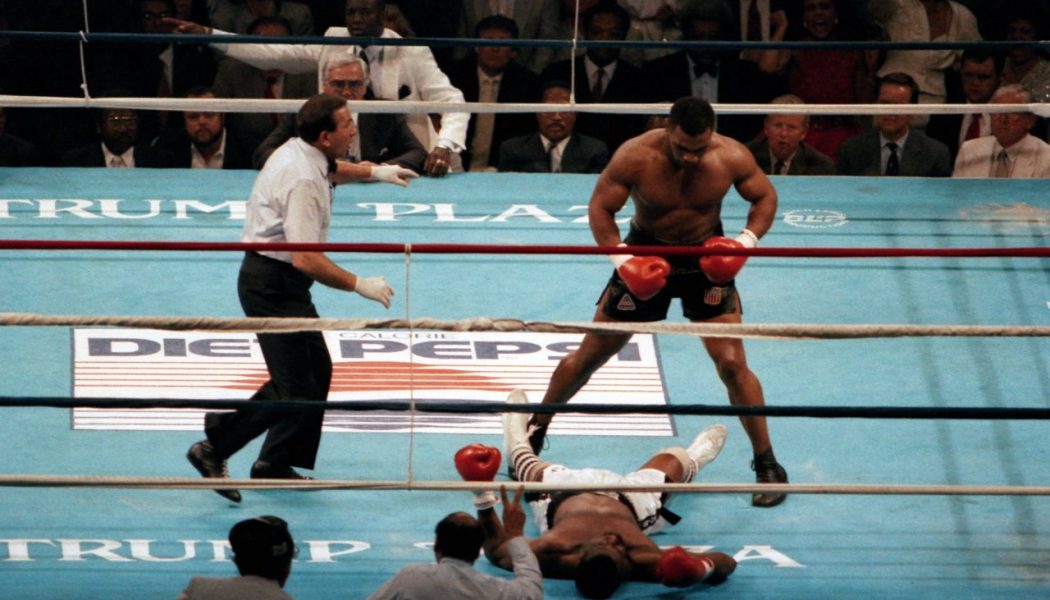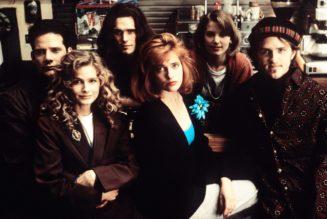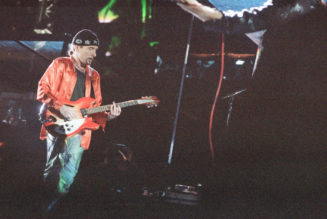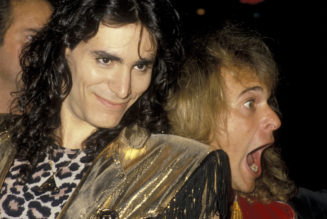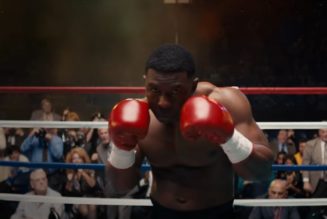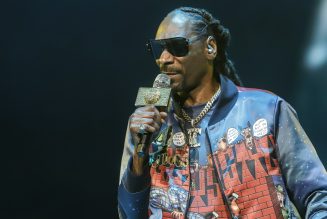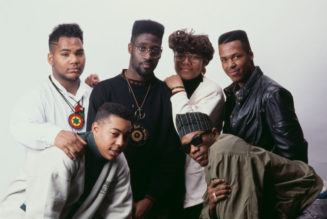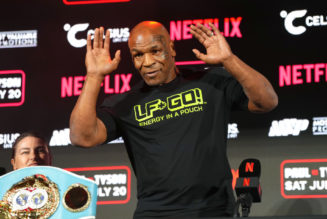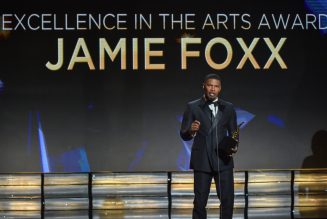This article originally appeared in the September 1988 issue of SPIN
As an arena for boxing, the Convention Hall at Atlantic City is not one of the happier architectural palaces of the world. It drops the kind of pall an audience that would come from witnessing a cockfight in a bank. Lyndon Johnson was nominated there in 1964 with two identical sixty-foot close-up photographs of himself on either side of the podium. The Hall looked on that occasion like a coronation chamber for a dictator. Now on the night of June 27, 1988, thousands of seats were laid out on the great flat floor and people in the seventeenth ringside were paying $1,500 a ticket to see Tyson-Spinks heavyweight championship. Since the gala glitz of Trump Plaza was but a connecting corridor away from Convention Hall, the Trump plaza was architecturally close to its purpose, possessing a retina-red decor in moving from gaming tables to the fight was as palpable as sex after midnight is distinguishable from the gray dawn.
The fight also took forever to start. Celebrities were introduced fifteen minutes and the successful gamblers had given back some of their winnings for a last-minute pair of tickets canal find a little consolation for bad ringside seats (catching a bout from the seventeenth row is equal to watching a couple make love in a room on the other side of the street.) To be able to boo or cheer, however, for Sean Penn and Madonna, Jackie Mason, Warren Beatty, Jack Nicholson, Michael Jordan, Magic Johnson, Marvin Hagler, George Steinbrenner (booed), Dexter Manley, Matthew Broderick, Carl Weathers, Burt Young, Judd Nelson, Chuck Norris, Oprah Winfrey, Don Johnson, Tom Brokaw, Don King, and Jesse Jackson, all in person, would revive the ego when telling about it to the folks back home.
At press ringside, where you can see the fight a lot better, the rumor was that Donald Trump had planned to invite Frank Sinatra to sit next to him but was worried that the rain floor might be pitched too high for Frank and other guests in the front row. So, the ring was lowered. Sinatra, working at rival Bally’s, declined the invitation. It was not appropriate to be seated next to the competition. The principle remains intact, however. Trump understood the psychology of success. It was more important that his front row contingent have a good view than that the suckers in the seventeenth pew complain because the rain has been pitched in a hollow.
Just before the fight began, Trump came into the ring with Muhammad Ali. Ali now moved with the deliberate awesome calm of a blind man, sobering all those who stared upon him. He looked like the Shade of the boxing world. “I, who gave you great pleasure for years, now ask that you to witness the cost of your pleasures,” he could as well have said. Then Trump standing beside him, was able to hear over his own PA system, “New Jersey thinks you, Donald Trump.”
Spinks came into the ring wearing white trunks. He was a much-respected fighter. He had won thirty-two fights and lost none. He had been light-heavyweight champion and moved up in weight to fight Larry Holmes, taking the heavyweight championship from Holmes by decision and keeping it in the return bout. He had knocked out Gerry Cooney in five rounds. He was an artfully awkward fighter who tried never to do the same thing twice, and he had been the underdog in many of his undefeated fights. He possessed a little of Ali’s magic – he found unorthodox ways to win. People who love the gallant, the sly, and the innovative, liked Spinks. He was invariably a little better than expected. Tonight, however, he did not look happy. He was smiling too much. In fact, Spinks seemed distracted and relaxed all at once. One had not seen that kind of separation from oneself since sitting next to Sonny Liston in a poker game the night before Liston’s second fight with Ali in 1965 in Lewiston, Maine. Liston had been the most relaxed man in the room. He had googled equally whether he won or lost. The stakes were nickels and dimes, but Liston took great pleasure in peeking at his hole cards before each round of betting. It was easy to mistake such relaxation as confidence, yet the following night Liston was knocked out in one round by a punch that some people are still insisting they never saw. It had not been relaxation that was witnessed at the poker game, but resignation.
So the sight of Spinks increased the pall. Spinks was giving a dry-mouth smile. His nervousness was evident; worse, it was deep. Boxers can come into the ring keen with fear, or rendered sluggish it, and Spinks did not look keen. It can well be an unendurable load to know for 100 nights that one is going to face Mike Tyson at the end of them, Tyson with his thirty-four victories and no defeats, his power, a speed, his ongoing implacable offense of force.
Tyson, however, looked drawn. Not afraid, not worried, but used-up in one small part of himself, as if the problem still existed that he had not been able to solve. His expression suggested how hard it was to hold off murderous impulses for a long time. He was waiting for the bell. The bell for the first round can toll like doom for any fighter who does not feel installed properly in his role, but for Tyson that first bell was the sound of heaven. Tyson came out like a mortar shell. The psychic blast of his presence was the first blow landed. You did not merely box Tyson, you faced the impact of his might. If, in the next forty seconds, Tyson threw seven murderous punches, and none landed, Spinks was able to answer but with one weak jab. The force of Tysons domination was established. The fight was following his pattern. Missing every punch he threw, he was nonetheless trolling all of Spinks’ space. Spinks could do nothing but dart in, back out and escape along the ropes. Then, he was caught with the first telling blow. Tyson whaled a right off Spinks’ hip socket, a wrecking ball three inches below the belt. Spinks limped away with his lateral mobility reduced. If he could not move quickly to the side, then he could not keep Tyson from cutting off the ring. Tyson pushed up the pressure, and unholy charismatic maniacal force of concentration—a left hook landed like a sledgehammer on Spinks’ down-bobbing head. That’s stunned him long enough for Tyson to drive a powerful right into his ribs. It was a punch his art derived from his last millisecond of choice. Tyson started to go for the head, saw a better opportunity to the body and made the choice in the glint of an instant left to him. Spinks went down in pain. He was used to men who could hit hard, and to boxers who were very fast, but he had never met the two in such close association before. He had the look on his face of a man who had just been washed overboard in a squall.
Spinks was up at three, nodding his head to the referee as the count went to its automatic eight. Yes, he was saying in effect, I’m all right, my head is clear, I’m ready to fight, nodding all the way, planning his last stand. He was going to throw one good punch before it was over. Tyson came steaming in. Each fighter threw a right, Spinks first, but Tyson turned his head and the blow merely grazed him. Spinks, however, caught Tyson’s right forecast on the side of his head. Spinks was down. Spinks rolled once on the canvas and collapsed into the lower ropes. The prize fight with the largest gate in history was over at 1:31 of the first round. Spinks had beaten his fear on every day but the most important day of his life.
Seem up close, it was a one-sided gem. You could not, however, realize how good Tyson was unless you sat in the immediate glare of his aura. Seen from a distance, the fight had to be a bankroll sized bummer. Men who had paid $1500 a ticket had to feel as if their wallet had been lifted.
People were subdued on their way out of the arena. The boxing fan is there to be had, and knows it. Part of the pleasure is to get taken. Boxing fans are bitter people, and the virtue of being cheated from time to time is that it confirms one’s lowest estimate of the world. Half of the great and most ballyhooed fistic encounters offer disappointment. Post-depression in Convention Hall, however, was deep. The heavyweight division now had nowhere to go. Not a fighter and say it was ready for Tyson, and boxing can hardly thrive when there is only one great heavyweight. It’s like living in a country where only one political leader has power: The situation reeks of oppression. How could you fight Tyson?
The true depth of the problem was that Tyson seem to thrive on problems. Eight out of twenty-two top sportswriters had put their picture on Spinks. That was because Tyson had suffered trials before the fight. His co-manager Jim Jacobs, had died. His new wife, Robin Givens, had a miscarriage. Then, Robin Givens Tyson, and Tyson’s new mother-in-law, Ruth Roper, had teamed up with Don King, the promoter for war with Bill Cayton, his other co-manager. Soon after, Tyson smashed his new Rolls-Royce and tried to give it away. Finally, Tyson acceded to his wife’s and mother-in-law’s desire to bring a lawsuit against his manager. This parade of family life has been given bestseller treatment in the newspapers. Since Tyson has been the darling of sports media for years, he could hardly understand why the media had turned on him. No one had told him that the media finds it tonic on occasion to enjoy those they love. Certain mistakes are not to be made. For instance, do not try to give your Rolls-Royce away. Tyson boiled and cauldrons of bad publicity.
A fighter needs his powers of concentration. The smart gambling money all over the world decided that Tyson was sufficiently distracted to make Spinks a good underdog bet. Iron Mike, the indestructible, might have an Achilles’ heel. The odds dropped from 6-1 to 7-2. That is like a drop in the Dow Jones from 2,000 to 1,000.
Yet, Tyson had shown no respect for the shifting odds. The distractions had seemed to intensify his force. His wife said, “If this is how he is when he is distracted, I would like to see how he is when he’s on.” What chance had anyone to find a way to go in the ring with him.
It is the key question. Our heavyweight champion, twenty-two years old, was now undefeated in 35 fights, 31 by knockout, 16 in the first round. He had been known to say, “I’m the toughest man on the planet.” When he was angry at press conferences, he was sure to say it again. It was true, or it was not true. Heavyweight champions, it has been observed or not like champions at lower weights. It is an adage that a good big fighter can beat a good little fighter. Indeed, even a mediocre heavyweight can demolish a good welterweight. Modesty sits upon one’s achievements, therefore, if one is not in the top weight. But it is possible that no one in the world can defeat a great heavyweight champion when he is ready for a fight. He can, conceivably, be the toughest man in the world. Or he might not be. A giant lurking in some Third World slum might be empowered enough to defeat him hand-in-hand in an alley, or the best wrestler in the world might be able to take his blows long enough to pinion him. Some martial artist in some far-off dojo could do something unforeseen. Speculations impossible to fill the brain of a heavyweight champion, and they are frightening. He has been anointed by God or the devil? Is he a freak, or some embodiment of a spirit of history? Is he himself, or a river of other people’s sentiments? Mania and depression sit at his left and his right hand. Is he beloved by all or envied by all? Can he trust anyone? He is a God amongst men but any bullet can stop him. (Sonny Liston was so paranoid that the march from his dressing room to the ring frightened him more than meeting Floyd Patterson.) So Tyson could not know his own nature; he could only be certain that others would try to take advantage of it. In the dressing room before the fight, Butch Lewis, Spinks’ manager, made his big play of the day. If Tyson was distracted, the good strategy might be to drive him into pre-fight furies. So Butch Lewis, who would be famous forever in management circles for having once refused to fight with Tyson that would’ve brought Spinks over $4,000,000, had been vindicated not two years later by this fight tonight in Atlantic City between the same principles now worth $13,000,000 gross to his fighter. Of course, Spinks had stopped Gerry Cooney and five rounds in the interval and that multiplied his asking price, but then everyone in boxing gambles on the future; Lewis had gambled and won. A certified legend, he could afford to dress like a joker. Tonight, he was wearing white tails, a white bowtie, and no shirt. His black skin gave him an elegant dark shirt he required.
Butch Lewis sent his brother to see what could be done about the wrapping on Tyson’s gloves. The brother found a welt in the tape. Before the screaming back-and-forth was over, Tyson began to pound the wall with his gloves.
Then, Lewis broke the agreement that Spinks would come into the ring ahead of Tyson. A quarter of an hour was lost before Spinks acquiesced to walking first down the aisle. Assuming that Lewis and Spinks were acting on a prearranged plan, this ought to have produced some advantage. It is worth a measurable bit to a fighter’s inner preparations if he knows that a fight will not start on time. The assumption was that Tyson, delayed and provoked, would be closer to hysteria than Spinks. Given Tysons numerous pre-fight irritations, this might magnify any dislocation now building up in his timing. After all, the master, Muhammad Ali, had always employed one fundamental pre-fight strategy: don’t go against 100 percent of the man if you can get him down to 50 percent.
Jose Torres, former lightweight champion, and recently retired chairman of athletics in New York, was in Tyson’s dressing room. A member of the same boxing family whose spiritual father is Cus D’Amato, Torres was close enough to receive confidences from Tyson. The dressing room with its dark stained plywood, fluorescent lights, TV monitor, and mirror, was a room about as cheerful as an empty coal bin, but it pleased Iron Mike Tyson. “I love these moments,” he said to Torres. “Man, do I love the ceilings.”
Such dialogue took place before the altercation with Lewis. Afterward, on the way to the ring, Tyson gave Torres a wink. The closer he came to the fight, the more he approached the center of himself. “I bet your purse and mine,” and Kevin Rooney, his trainer, on the walk to the ring, “that you will knock him out in the first round.”
“Where is the money?” asked Tyson of Rooney as soon as the fight was done.
“Mike,” as Rooney would explain later, “is a little dry in his humor.”
So Tyson had avoided the two pitfalls that are waiting for a fighter on a high-voltage fight night: excessive fear and excessive range. He has been cool and close to his fear. “Of course I’m afraid,” he told Torres, “but it doesn’t affect my conviction that I’m going to hurt this guy in a few minutes.” He walked the other tightrope as well, the line between controlled violence and blind hysterical rage. The demand was clear. It was to be able to use the anger aroused by every injustice done to one, every oppression, cheat, bitchery, double-cross, blind-sided blow, every frustration in one’s life yes, put all into that one’s physical strategies in the rain. Such anger, once transmuted into discipline force, can fill the fighter’s energies, give power to his punches, and get him off the floor when he is in trouble. It is one of the most difficult psychological transactions in human endeavor. For such deep anger is but a step from blind rage which is disaster for the fighter. Blind rage freaks punches off their aim, burns out the lungs, expropriates the rhythms of the heart, and leaves you wild and rudderless.
The separation between controlled violence and blind rage is, therefore, sacrosanct to a great fighter. He must generate hostility for his opponent (or else the possibility of losing will not seem sufficiently monstrous). But he must also allow no more emotion to arise than he can control. It is equal to saying: the furies of a psychopath are to be brought under executive action. We are obviously near the advanced course in martial arts.
Yet to understand by Tyson (if only to obtain a clue to the kind of fighter who might someday defeat him) it is important to recognize that such understanding will not be found through interviews. Fight reporters work to get one good quote from the champion. It is probably meaningless. If one were to observe Kurt Vonnegut, Saul Bellow, William Styron, or John Updike jogging, one might learn a little about them, but it would not compare to the comprehension of their psychology that we can pick up from their books. Author reveal themselves best through language; fighters through body language. One learns about a fighter’s character by comprehending his boxing style, not by his offhand remarks. To begin to understand Mike Tyson, when hast to go to the root of his intellectual beginnings, which is to say the root of the methods imparted in his training. We are carried back, therefore, to Cus D’Amato, dead for three years, but alive in the mind of everyone who knows Tyson well, for D’Amato was Tyson’s spiritual father, surrogate father, coach, and training philosopher.
Not many philosophers, however, looked like him. Middle height, bald, sturdy as a barrel, D’Amato had a Roman senator’s face with the lineaments of a street added to his expression.
The ground of D’Amato’s metaphysics was fear and violence. His pupils were ghetto kids who had never read a book. It did not matter. What D’Amato could impart was of intellectual interest to them. He was, in effect, a consul who could grant them an exit visa from the ghetto. Tyson was the most successful of all of D’Amato’s adopted progeny, but Tyson came at the end of a long line. D’Amato had guided Floyd Patterson and Jose Torres to championships before Tyson was even born. Over the last 10 years, however, D’Amato had chosen to live in seclusion in Catskill, New York, and worked in the town gymnasium above the Police Department on Main Street. Tough kids and problem kids lived on the top floor of his house and were trained with him to become fighters. Most were novices, a few had talent – most, sooner or later, moved on, or moved away.
Seasonally, particularly violent, ingrown, inarticulate, and greatly disturbed Black or Hispanic would come along for whom D’Amato could be father, high priest, and the spirit of even handed justice. Floyd Patterson, Buster Mathis, and Mike Tyson are three examples. Tyson, for instance, was in a reformatory near Rhinebeck, until his athletic coach, a former professional named Bob Stewart, brought Tyson over to the Catskill gym, and boxed with him in front of D’Amato who was sufficiently impressed to accept Tyson at the farmhouse and take on the problems of his not undisturbed personality. Crucial to D’Amato’s method was that he had no fear of being alone with difficult young fighters. He could get them to talk. He could comprehend their problems. He could enrich them. First their minds, eventually their wallets. To a certain kind of slum kid, it was the Holy Grail – a man who could show them how to fight at a higher level. That was equal to new thought. For a ghetto kid, the hope of thriving in the ring is like a vision of a horse when one is lost in the desert.
So he introduced them to the management of fear and violence. It took years. It took monostatic physical training, and the discipline of a method. D’Amato had invented a new kind of defense. Departing from the classic Irish stand-up style, right hand high to protect the head, left extended, body in profile, D’Amato taught his fighters to keep both hands in front of their face, their shoulders square to the other fighter, their stance a crouch. Done properly, it was difficult for the other fighter to find an opening. It was equally difficult, however, to get one’s own punch off and look good doing it! A boxer’s style is precious to him. His vanity can be centered on that. No one ever boxes who is not interested in us interested in nourishing his vanity. Many are young boxers, in consequence, hated the peek-a-boo. It took too long to learn. Once acquired, it produces other problems. A fighter schooled by Cus D’Amato was hard to hit. Promoters did not like the style. It made for cagey fights. Nor did sportswriters, hooked on a “Took-him-out-with-a-left-to-the-body-and-a-right-to-the-head,” feel at ease with D’Amato’s terminology. He taught fighters to look at boxing in terms of pattern. D’Amato was talking aesthetics. The pattern was your aesthetic. When successful, it obviated the other fighter’s aesthetic. He was now obliged to live with your fists, not his own. Riding on good stamina through the rounds was one by-product of establishing the pattern. Early exhaustion in a fight spoke not of poor condition – good fighters are not supposed to be in bad shape – but of frustration. Dominate the other fighter, and your energy would return.
In power, according to D’Amato, owed more to deception than brute force. Any boxer’s defense that was not startled by a punch, could not be hurt too critically. It was equal to saying that the fighter was hurt less if he could see the punch coming. The alert brain did not suffer so much as the brain surprised.
Installed above these factors, was ego. Ego carried you through discouraging rounds, ego enabled you to recapture the pattern. Loss of ego was next door to fear, inasmuch as loss of ego made your opponent more prominent. You began to think of him. You began to react to him. Soon, you were following his pattern. Part of D’Amato’s method was to reinforce the ego of his fighters. Ghetto kids invariably have problems of identity. Yet without a purchase of identity, one cannot possess battle-proof ego. So, D’Amato supplied the identity. A fighter, schooled by him, had learned a new vocabulary (and vocabulary is usually equal to dignity in the slums). Now, a kid had his training to draw upon for his identity. This could be sufficient to take him through early fights. As the stakes rose, however, the force of one’s ego might have to reach for the megalomaniacal. “I am the toughest man on the planet,” says Tyson. Anything less might produce hesitation as he moves in. The other fighter, after all, it’s not without his powers. Torres, the contender, training in 1965 for his light-heavyweight championship match with Willie Pastrano, sat with D’Amato one night studying films of Pastrano’s previous fight in England. When it was over, D’Amato said, “Jose, there has never been any doubt in my mind that you were going to beat Pastrano, but now, having studied this film, I know that as I look at you, I am going I’m looking at the next light heavyweight champion of the world!”
By such means had D’Amato succeeded in giving a few of his fighters clear purchase on a new identity. Through emphasis on their physical technique, their concentration, their vocabulary, their knowledge of boxing strategy, through the mindset that they were intelligent and ready to solve problems, they were able to enlarge the reservoir of their passions sufficiently to withstand sudden floods of violent emotion. That was half of the technique. The other was to domicile their fear. From his earliest instructions, D’Amato was directing them toward the best use of their fear. To a fighter getting ready for his first walk into a real ring (as opposed to sparring at a gym) D’Amato would say, “When you see the other fighter, you were going to feel afraid. You will look at how big his muscles are. He will impress you. But remember, all while you were looking at him and feeling afraid of him, he will be looking at you, and your muscles, and he will be just as afraid of you.”
That was the introduction. The advances lessons would go on for the rest of their lives. One was not supposed, Cus warned, to rise above fear, certainly not to the point where one no longer reacted to it. A fighter going into the ring unafraid was a fighter anesthetized. One had to live with one’s fear. One had to comprehend its perverse turns, its temptations, its deceptions; one had to live as close to one’s fear as to one’s fists. Confidence and fear had to communicate with one another constantly. D’Amato had a tale to tell for the advanced course.
“Back in my neighborhood in the old days,” Cus would explain, “we had a pretty tough neighborhood. But there was a guy from another gang who used to come around, and the fellows on my block used to be afraid of him. He was a knife-fighter. He was the best around, everybody said. Well, one day he came into the neighborhood, and invited each of the guys to challenge him. He knew, of course, that nobody would. Then, he began to taunt them. He said things he shouldn’t have. By the time he left, he had humiliated a lot of people. When I got back that night from work, and heard about it, I was so sick. So I went over to his block and challenge him to a fistfight.
“‘I don’t go in for that,’ he said. ‘Meet me with a knife.’
“’All right,’ I said, ‘I’ll meet you with a knife.’
“We arranged to have a knife-fight, just the two of us present, at seven o’clock the following morning in a deserted warehouse that was situated between our two neighborhoods. No witnesses. That was so there would be nobody to rat if one of us got it. I went home after we spoke. I was as afraid as I ever been in my life. You see, I didn’t know anything about knife-fighting.
“‘Still,’ I told myself, ‘it must be approached as a problem. Problems have solutions.’ So I counted up my assets. I knew a lot about boxing. The question, then, was how to adapt my particular skills to a radically different medium. I thought about it for a while and came up with the answer. I would fight his knife with an icepick, but I would use boxing methods. Therefore, I took an ice pick out of the kitchen and shaved down the handle until it was more like a slat than a cylinder. Then, I taped this adapted icepick to my left palm in such a way that the point could stick out between my middle fingers when the fist was closed. Then I took a windbreaker and wrapped my right arm for defense. Next, I shadowboxed around my cellar. I knew I was not without some possibilities in such a situation.
“Then, I tried to sleep. I didn’t manage that, but nonetheless I made myself rest. At six in the morning I got up, gather the equipment, and at six-thirty I was in the warehouse. I wanted to be in the place before him so that I could look everything over.
“At a quarter to seven, I taped the ice pick to my left hand, and wrapped the coat around my other arm. I kept shadowboxing in order to prevent myself from tensing up. At seven o’clock he was not there. At ten after seven, he is still hadn’t shown. At twenty past seven, I said to myself, ‘Maybe he will not appear.’ Then I could tell by the power of my sentiments of relief, how afraid I was. So I commanded myself to banish all such thoughts. They could only progress into weakening me. If I started to hope that he shouldn’t wouldn’t show, I would have less determination to fight if he ever came through the door. So, I kept waiting, and kept moving. I did not allow myself to believe that there would be no fight until the time was a quarter past eight. By then, I know he would never present himself. He had lost his nerve. I went home, and can say that it felt legitimately like a victory for me. That was how everybody looked in the neighborhood. He never came around our street again.”
The logic was established: live with fear as if it is your brother, your mother, your wife.
An answer appears to fighting Tyson. Before one can defeat him, one would do well to understand him – understand, that is, not his psychological depths — Ali, D’Amato, or Robin Givens might be better suited for that – but grasp the structure of his professionalism, learn to think about boxing in the manner that he does, understand his moves, live with them as closely as one lives with one’s own boxing technique, yes, if one had a great young heavyweight coming up, it would be wise to look for one of the few trainers left who has been schooled in D’Amato’s method, so that one could submit ones fighter to those disciplines. It is still a dubious gamble. Yet, the kind of fighter to offer serious confusion to Tyson might be the one who knew not only what Iron Mike was doing, but what he was preparing, and so could steal enough of the primeval lighting to lift a corner of the pattern. That might extract Tyson in some impregnable power of concentration imparted by D’Amato. A long shot, but a live one. Almighty dedication can only be overcome by equal dedication and somewhat greater wit.
